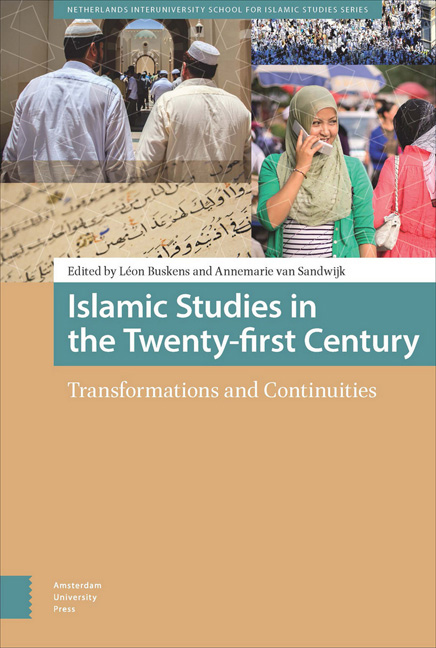Book contents
- Frontmatter
- Dedication
- Contents
- Preface
- Introduction: Dichotomies, Transformations, and Continuities in the Study of Islam
- Islamic Texts: The Anthropologist as Reader
- Textual Aspects of Religious Authority in Premodern Islam
- What to Do with Ritual Texts: Islamic Fiqh Texts and the Study of Islamic Ritual
- Textual Study of Gender
- Scholarship on Gender Politics in the Muslim World: Some Critical Reflections
- Power, Orthodoxy, and Salvation in Classical Islamic Theology
- Dialectical Theology in the Search for Modern Islam
- “Classical” Islamic Legal Theory as Ideology: Nasr Abu Zayd’s Study of al-Shafiʿi’s al-Risala
- Islamic Law in the Modern World: States, Laws, and Constitutions
- Vernacular Cosmopolitanism as an Ethical Disposition: Sufi Networks, Hospitality, and Translocal Inclusivity
- Middle Eastern Studies and Islam: Oscillations and Tensions in an Old Relationship
- Notes on Contributors
- Overview of NISIS Autumn Schools, 2010-2014
- Index
Middle Eastern Studies and Islam: Oscillations and Tensions in an Old Relationship
Published online by Cambridge University Press: 12 December 2020
- Frontmatter
- Dedication
- Contents
- Preface
- Introduction: Dichotomies, Transformations, and Continuities in the Study of Islam
- Islamic Texts: The Anthropologist as Reader
- Textual Aspects of Religious Authority in Premodern Islam
- What to Do with Ritual Texts: Islamic Fiqh Texts and the Study of Islamic Ritual
- Textual Study of Gender
- Scholarship on Gender Politics in the Muslim World: Some Critical Reflections
- Power, Orthodoxy, and Salvation in Classical Islamic Theology
- Dialectical Theology in the Search for Modern Islam
- “Classical” Islamic Legal Theory as Ideology: Nasr Abu Zayd’s Study of al-Shafiʿi’s al-Risala
- Islamic Law in the Modern World: States, Laws, and Constitutions
- Vernacular Cosmopolitanism as an Ethical Disposition: Sufi Networks, Hospitality, and Translocal Inclusivity
- Middle Eastern Studies and Islam: Oscillations and Tensions in an Old Relationship
- Notes on Contributors
- Overview of NISIS Autumn Schools, 2010-2014
- Index
Summary
Introduction
In Middle Eastern studies Islam and Muslims have become the dominant concern, almost obscuring many other aspects of societies and cultures in the past and the present. The current situation is yet another stage in a long historical development of a scholarly tradition which seems to be structured by oscillations, or Gellnerian pendulum swings, between interest in Middle Eastern languages and literature on the one hand and Islam on the other. Although Middle Eastern studies and Islamic studies are different fields of inquiry, with their own traditions, they are so closely related that next to cooperation and cross-fertilisation, tensions and trouble seem unavoidable.
First I will briefly discuss ideas about the Middle East as an area and the history of Islam as an object of research, and the intertwining of these two categories. I will limit myself to some indications of the historical roots of the present debate. Then I focus on major transformations during the last forty years in subjects and approaches, resulting in a new dominant model produced in the United States and reproduced in English worldwide. I will conclude with some critical notes about the merits and weaknesses of the current ways to study Islam and the Middle East, including some observations on the use of the concepts “religion” and “culture.”
Many of the standard references are unavoidable. But I deliberately mention less mainstream materials as well, in order to show that the tradition is much richer and more diverse than the hegemonic model. Alas, limitations of space, and my lack of knowledge of languages and publications that are difficult to access, do not allow me to be as inclusive as I would like to be.
The Middle East as an Area
As a category, the Middle East is a European image, as are many other areas (cf. Lockman 2010). Through the centuries the ideas associated with the region have been vital for Europe to imagine itself. Although the peoples of the Middle East have a long history of thinking and writing about themselves in many languages and scripts, for example, using notions in Arabic such as jazirat al-ʿarab, al-mashriq, al-maghrib, umma, and dar al-islam, the notion of the Middle East has become natural to them in the meantime, as the name of the Saudi-backed newspaper Asharq al-Awsat shows, for example.
- Type
- Chapter
- Information
- Islamic Studies in the Twenty-first CenturyTransformations and Continuities, pp. 241 - 268Publisher: Amsterdam University PressPrint publication year: 2017



